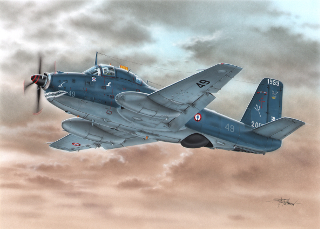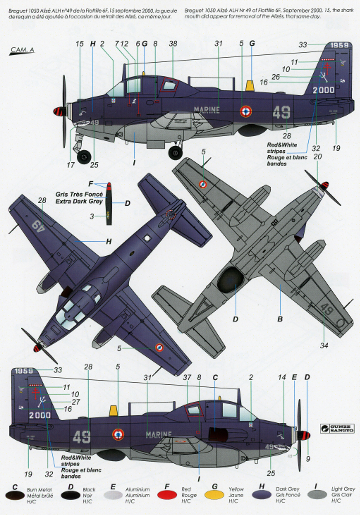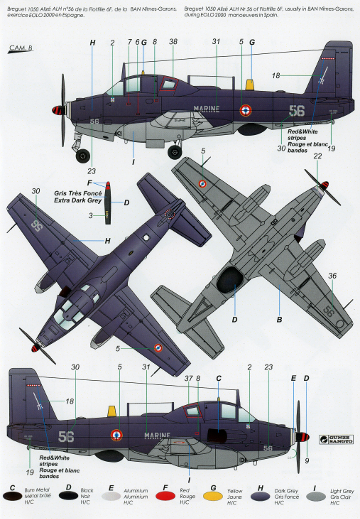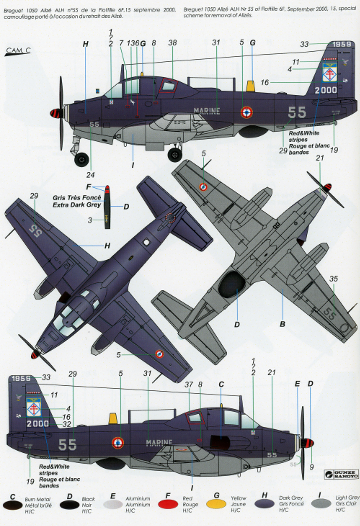FR0030 Breguet 1050 Alizé ALH
History :
The Breguet 1050 Alizé carrier-based Anti-Submarine Warfare (ASW) aircraft was derived from the Breguet 960 Vultur, an unsuccessful attack aircraft design that was limited to only three prototypes. Three prototypes and two pre-production machines were built, with the first delivery of a production machine to the French Navy being made on November 15, 1957.
The Alizé replaced the Grumman Avengers in the submarine hunter-killer role, with 6 Flotille (6F) being the first squadron to receive the Alizé in 1959. 6F served as an operational training squadron, familiarising both flight crews and support personnel with the new aircraft.

Alizés served with 4F, 6F, and 9F, as well as various ancillary units including 2S, 3S, 10S, ERC, EPV and 59S. Embarked aboard the carriers Arromanches, Clemenceau and Foch, Alizés participated in many exercises like Atlantis 69 and Alligator III, and on operations including Saphir in the Gulf of Aden, Olifan over Lebanon, Prometheus and Salamandre in the Gulf of Oman, Balbuzard in the Adriatic Sea, and Trident over the former Yugoslavia.
The Alizé underwent its first upgrade between 1966 and 1970 with no change in model designation, although some aircraft serial numbers were temporarily re-assigned in the 100 series, meaning for example that aircraft 45 became 145. Later, between 1978 and 1983, thirty Alizés were modified to a standard designated as ALizé Modifié (ALM). These machines were equipped with a new Thompson-CSF DRAA-10A Iguane radar using impulse compression, an ARAR 12A radar detector, an Omega Equinox navigation system, and a system to analyse data emitted by acoustic buoys.
Between 1996 and 1997, fifteen ALMs were further modified to ALizé mis à Hauteur standard (ALH). The main improvements were to the automatic pilot, navigation and ESM systems, plus the addition of a Thomson-CSF TTD Chlio FLIR camera in the left wing nacelle. These modified planes no longer carried external weapons. The ALH-standard Alizes served only with 6F.
Any unmodified airframes were identified as Alizé 1st Generation, to distinguish them from those with later upgrades. At end of its service life the Alizé was used for coastal and sea surveillance. The last Alizé (ALH) retired from service with 6F in 2000, although a few remained to be seen on some French bases after this date. Alizé number 59 was returned to flight status and given the civil registration of F-AZYI.
India bought fourteen Alizés for service aboard the carrier INS Vikrant. Alizés fought in the Indo-Pakistan conflicts of 1965 and 1971, when they were involved in the hunt and destruction of one Pakistani submarine, but also lost an Alizé (serial number IN203). Indian Alizés were all 1st Generation airframes, and served from 1960 to 1991. Attempts to export the Alizé to Brazil, the Netherlands, Peru, Israel and Indonesia were pursued but did not lead to sales.
Specifications : All-weather carrier-based monoplane used in the SAR, anti-surface, and anti-submarine roles, three-crew members (pilot, navigator, and radar-operator). Engine: Rolls-Royce Dart 21 turboprop, delivering 1950 cv. Wingspan 15.60 m, length 13.86 m, wing area 36 m2. Economic cruising speed at 182 knots (336 km/h), normal endurance 4 hours, range 2035 km.
Documentation :
- Breguet 1050 Alizé, Arnaud Prudhomme, Histoire et Collections (in french, 68 pages)
- Antennas on tip of wings have been forgotten (please see box art)
Camouflage schemes:
- Breguet 1050 Alizé ALH Nr 49 of Flottille 6F, September 2000, 15, the shark mouth did appear for removal of the Alizés, that same day.
- Breguet 1050 Alizé ALH Nr 56 of Flottille 6F, usually in BAN Nîmes-Garons, during EOLO 2000 manoeuvers in Spain.
- Breguet 1050 Alizé ALH Nr 55 of Flottille 6F, September 2000, 15, special scheme for removal of Alizés.


